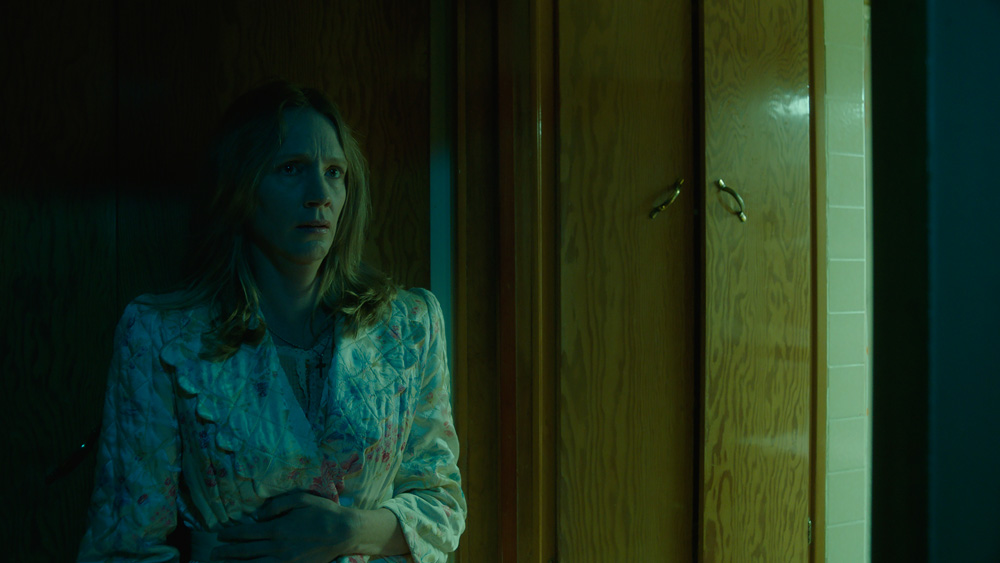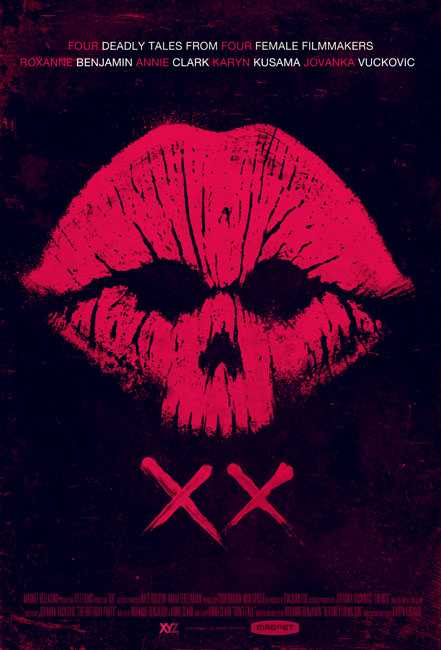XX
“Four Deadly Tales from Four Female Filmmakers”
Directors: Jovanka Vuckovic, Annie Clark, Roxanne Benjamin, and Karyn Kusama
Starring: Natalie Brown (“The Box”), Melanie Lynskey (“The Birthday Party”), Angela Trimbur (“Don’t Fall”), Christina Kirk (“Her Only Living Son”)
Opens February 17: In Theaters, on demand, on Amazon and iTunes
If you are seeking to be disturbed, XX gives you plenty of options. The new horror anthology offers up four short films, all directed by women with female leads, plus some wonderfully creepy stop animation interstitials. Each film represents a different style of telling a horror story. Jovanka Vuckovic, Annie Clark (a.k.a. St. Vincent), Roxanne Benjamin, and Karyn Kusama direct four films distinct in tone and approach. There is psychologic terror, mystery, body horror, a tale of ordinary madness, family drama, plus a monster or two. For those who need to be warned, there are a few spoilers ahead.
First up is “The Box,” based on Jack Ketchum’s Bram Stoker Award-winning short story of the same name. The concept is simple and elegant, worthy of Edgar Allan Poe. Susan and her two young children are on their way back home on the train just before Christmas. Seven-year-old Danny, excited for Santa’s visit, can’t resist asking the stranger next to him what’s in his shiny red box. After he looks, Danny is no longer excited. Back home, he stops eating. His parents can’t figure out what’s bothering him as he becomes increasingly gaunt and standoffish. As the tension mounts and the mystery deepens, we learn that Danny’s disturbance is contagious when it spreads to his older sister.
The story is told from the mother’s point of view, and her hysteria is palpable as she watches her family crumble, reaching a crescendo in a dream sequence in which she makes the ultimate sacrifice to end the trouble. Vuckovic, who directed and adapted the screenplay, keeps the frustrating mystery up to the very end of the story. It’s an advantage of the shorter format that she doesn’t necessarily have to solve it. She can leave Susan, and by proxy the audience, to speculate. Bring them to the point where they have to know and them leave them there with a knot in their stomach.
Annie Clark seems to have had the most fun directing “The Birthday Party,” which she co-wrote with Roxanne Benjamin. Like the music she makes as St. Vincent, it is colorful and bizarre, joyous in a way. In her director’s statement, Clark admits her segment is more black comedy than straight-up horror. Pure horror gives her too much anxiety. “One look at a serial-killer raising the knife the moment before the blood-plunge,” she says, “a child possessed by a demon, a malevolent ghost haunting a remote cabin, and I cannot sleep forever.” So she took a few things that give her the most anxiety – death, humiliation, and being responsible for children – and tied them together in a story about a child’s party gone horribly wrong.

Mary wakes up to a bright new morning looking like she’s about to attend her own funeral. It’s her daughter’s eighth birthday, and she’s having a costume party for the neighborhood kids and their nosey parents. The nicely-appointed house is already decorated, apparently by an assistant named Carla, with black and white streamers and balloons. Mary adjusts the taxidermied cat on the counter and tries to muster the strength to get dressed and face the day. She doesn’t think her husband is home yet to lend a hand. Turns out, he’s home, but he’s slumped over in his chair in his office, dead from an overdose. What follows is Mary’s hilariously futile attempt to put a happier face on the day, quite literally, as the neighbors and kids flow into the house and start the dance. She doesn’t even get a chance to change out of her nightgown. No matter. She has a flask. She nearly gets away with her plan to hide dad, at least until Lucy can enjoy her party, but alas, she has made a very poor choice of disguises. That’s where all of Clark’s anxieties come flying out at once before the punchline, a perfectly-timed cut to the title card and multiple subtitles that get successively more laugh-out-loud funny. The horror that compels the story isn’t supernatural or suspenseful, it’s the knowledge that Mary is doomed, and every decision is making it worse, until that moment when time slows down just before it all crashes.
Roxanne Benjamin wrote and directed “Don’t Fall,” the most conventional horror film in the bunch. Four hikers are making their way on a dusty, rocky desert trail, wondering aloud where the hell they are. Jay brags about his faithful internal compass. Never a good sign for the characters’ enduring health when one of them tells the rest essentially, “Hey, don’t worry” in the first couple of minutes. Especially when that’s followed by the discovery of some spooky paintings of a horned creature on the rocks, a painting they assume to be ancient. All four have obvious faults to exploit. Paul is a joker and a stoner. Jay thinks he’s got everything figured out. Jay’s sister Gretchen pushes Jess when they’re all looking over a steep cliff as a joke, one that’s not terribly funny to someone who’s afraid of height like Jess. Jess’s biggest fault, her fatal fault, is that she’s a tagalong.

Late that night, Gretchen wakes up in a cave and finds that the horned creature in the painting is very real. It only shows itself briefly, a vibrating shadow, a kind of bug devil. When Jay finds her, she is mutating into a beast that makes quick work of Jay and Paul, and Jess is left running in the dark trying to escape. “Don’t Fall” functions in a similar manner to the Scream movies. Benjamin keeps the tropes coming as if she’s preparing the audience for the Horror SATs, which is what makes this so fun. By the time you sense one coming, you’re already deep into it, and well on your way to the next. Except the characters seem to exist in a world in which no one has seen a horror film, so they’re clueless about the ramifications of their actions. Napalmed with facepalms.
The most ambitious film in this collection, from a storytelling perspective, is “Her Only Living Son,” written and directed by Karyn Kusama. It’s enigmatic, never dealing with its subject matter by name. Kusama gives you the horrible outline and lets you draw in the details. The story centers on mother and son Cora and Andy. We know Cora needed to escape someone, to raise Andy, but we don’t know who. We just get a doctor giving her some money to help her disappear. The story picks up again on the verge of Andy’s eighteenth birthday. He’s a dangerous kid, likes to torture animals and, as it turns out, his schoolmates. He’s in need of discipline, but everyone around Cora seems to be convinced Andy is something special. His high school principal won’t punish Andy for tearing out a girl’s fingernails. Cora finds him in the bathroom one night covered in blood, and he screams about her invading his privacy and storms off, leaving her to clean it up.

Everything starts to twist. The nice mailman tells Cora that Andy’s real dad, not the Hollywood star he thinks is his deadbeat dad, is coming to claim him. Andy is changing physically, too, trying to keep his box of discarded claw-clippings away from his mother in a box under his bed. That’s when we learn that Cora isn’t just the put-upon mother of a delinquent teenager. She’s smarter and stronger than we’ve been led to think, maybe even stronger than what’s coming for her son. The final scene of “Her Only Living Son” is the emotional high point of the collection, the reason why this film had to be last. It’s a beautiful, heartbreaking moment, a definitive ending that nonetheless preserves a sense of wonder, something to linger on while the credits roll.







